Student Spotlight: Embedded with New York Philharmonic
Editor’s note: As part of the UMS 21st Century Artist Internships program, four students interned for a minimum of five weeks with a dance, theater, or music ensemble part of our 2015-2016 season. Evan Saddler is one of these students. This summer, he was embedded with the New York Philharmonic.
Below, Evan shares his travel stories with the orchestra in advance of their return Ann Arbor for three concerts October 9-11, 2015 and many surrounding residency activities.
It was April 1, 2015 and I hadn’t heard back from UMS about the 21st Century Artist Internship. Despite the feeling that I had done well in the intense interview process (in front of a panel of eight core UMS staff members), I assumed that no communication meant that I hadn’t made the cut; thus I began to make other summer plans. Later that same evening however, a voicemail appeared in my inbox. It was one week old. The contents of this stale voicemail: Jim Leija, Director of Education and Community Engagement at UMS, was informing me that I would be moving to New York in less than a month’s time to intern with the New York Philharmonic. I contacted Jim right away, apologized for my tardiness, and accepted the offer diligently.

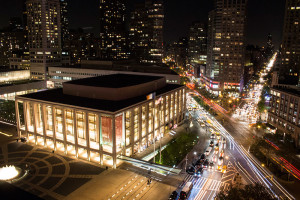
Photos: On left, lower Manhattan taken from the Manhattan Bridge. On right, a view from a rooftop looking down at Avery Fisher Hall at Lincoln Center, home of the New York Philharmonic.
My world went into chaos mode. The end-of-year to-do list was perpetual. I was finishing up classes and projects in Ann Arbor, preparing for exams, and performing my Junior Recital. And now I also had to find a place to live for six weeks in Manhattan, book the flights, and prepare for an experience of a lifetime. Also, I didn’t know exactly what I was getting into. I had a phone interview with my boss to-be, Vice-President of Artist Planning at the New York Philharmonic Ed Yim, followed by follow-up interviews with two members of his team. Thankfully, both phone interviews went smoothly, and I got the green light. I would have many more interviews to come, I discovered, and these interviews would become a crucial component of my internship.
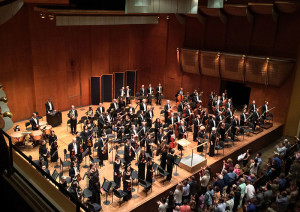
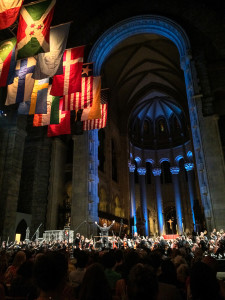
Photos: On left, after a performance of Brahm’s Symphony No. 4 with Manfred Honeck. On right, following a Memorial Day concert open to the public at St. John The Divine Cathedral on the Upper West Side.
The school year drew to a close, and I found myself transplanted to New York City. I was fortunate to be put in contact with the fabulous Lauren Flanigan, an operatic-soprano who has sung with the New York City Opera and the Metropolitan Opera. She runs a wonderful organization called the Music and Mentoring House. Lauren has created an incredibly supportive environment that caters to young artists studying, auditioning, and transitioning to living in New York City. She graciously took me in and allowed me to stay in her gorgeous Harlem walk-up brownstone townhouse for six weeks. She even cooked breakfast and dinner Monday through Friday for all of us living in the house. In addition, every Sunday evening before the work week began, all of us students living in the house, and some of Lauren’s close friends, colleagues, and neighbors gathered for what I called “family dinner”; a grill-out on the back patio (yes, in New York City) enjoying food and wine, discussing music, art, life, and one another’s company. It was always a highlight of my week. In addition to all of that, Lauren also set up a lesson for me with drummer Barry Altschul, one of Chick Corea’s early drummers. The entire situation could not have been better.


Photos: On left, family dinner, a weekly Sunday-evening tradition at Music and Mentoring House, which included grilling out and celebrating summer with new friends! On right, the goodness I woke up to before leaving for Lincoln Center; one could say we had it made at Music and Mentoring House.
I cherish the time that I had during my internship with the New York Philharmonic. I learned a great deal about the inner-workings of a world-class performing-arts organization, experience that will be invaluable to me moving forward. The extent of planning, precision of logistical execution, leadership, and effort on the part of everyone, on a daily basis at Avery Fisher Hall, is astounding. Most of this work is unseen by the average concertgoer. In addition to day-to-day administrative duties, I conducted formal and informal interviews with countless people within the New York Phil. The interviews helped me to see how component parts makes up the whole. Whether I was meeting with someone from the marketing department, the production team, the archivists, a musician in the orchestra, or the president of the organization, everyone was passionate about making a positive contribution to the forward momentum of the organization to ensure it’s longevity in the ever-changing 21st century’s musical and artistic climate.

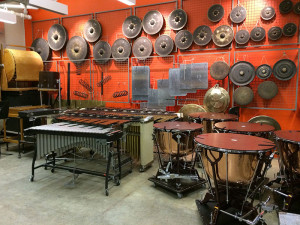
Photos: On left, taken during my video interview with President of the New York Philharmonic, Mr. Matthew VanBesien; the culmination of my series of interviews with people throughout the organization. On right, Associate Principal Percussionist Daniel Druckman took me on a brief tour of the Philharmonic’s extensive percussion collection.
Each week, I was able to attend rehearsals and the orchestra’s concerts for free, a tremendous gift of this internship. I observed and was a part of weekly production meetings, which outlined logistical aspects of upcoming performances at Avery Fisher Hall and around the city, and was also put to work in the Artistic Planning department on many communication and planning agenda items for the orchestra’s upcoming residency in Shanghai, China. Scheduling those conference calls between Shanghai and Manhattan (a 12-hour time difference) was no easy feat! Neither was learning how to use the office telephones; during my first week I accidentally hung-up on a board member (among many others!) while trying to transfer calls. You could say there was a bit of a learning curve to my office know-how.
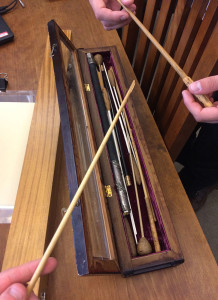
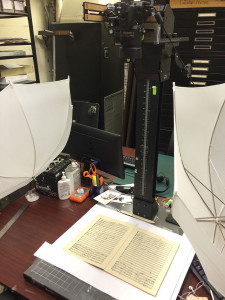
Photos: On left, during a visit to the Archives, I was shown a collection of batons owned by none other than Leonard Bernstein. On right, an interesting process through which the archival team uploads scores to the public online database. This is done through photo (with camera mounted vertically) rather than through scanning or copying.
Not only was I able to work at the New York Philharmonic at Lincoln Center for six weeks, I also lived in one of the greatest cities in the world. Practicing photography, attending concerts outside of the Philharmonic, going to museums like the MET and MoMA, and exploring chic restaurants in the Village occupied my nights and weekends.
I cannot thank the good people at UMS and the New York Philharmonic enough for this wonderful opportunity. The experience will stay with me for a lifetime, and I cannot wait to share its stories with others.
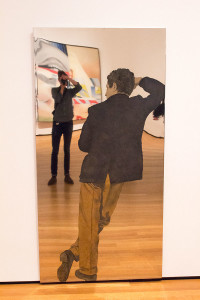
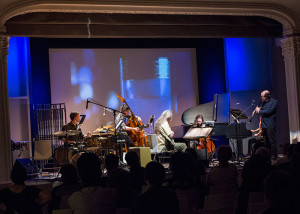
Photos: On left, taken on one of my off days exploring the Museum of Modern Art. On right, one of the great privileges of living in New York City during the early months of summer was the vast number of concerts going on at any one given moment; this was at a performance by Bang on a Can.
The New York Philharmonic returns to Ann Arbor October 9-11, 2015.
Interested in more? Explore New York Philharmonic in our archives.
What are the different kinds of marching bands?
Marching bands are prevalent in modern American society, from ushering in the beginnings of parades to entertaining the masses during football game halftime shows.
Did you know that there are many variations of marching band, each with their own style and traditions? Find out what makes a marching band.
1. The Military Band
The modern marching band originates in the military band tradition. Military bands are characterized by straight, organized ranks that move in the forwards direction. Clean and precise, military bands put a heavy emphasis on the uniformity of their visual style. Military bands often play national or patriotic tunes. The art of the military band isn’t as popular as it was, but some do exist, notably the Texas A&M Fightin’ Texas Aggie Band, the largest military style band in the country. In addition, many United States military bands form marching ranks for particular occasions, such as inaugural parades.
2. The Drum and Bugle Corp
Other styles of marching band borrow elements from the military band, but add their own unique flair. For example, the Drum and Bugle Corps borrows elements of the military’s regimented nature, but make formations that can be more organic and even pictorial. In addition, Drum and Bugle Corps freely move both backwards and forwards. Band members often “traverse” or “slide” so that their upper bodies consistently face the front of the field, ensuring a constant wall of sound no matter what direction they move. These elements can be manipulated to create various effects in dynamics.
Drum and Bugle Corps aim to imitate the artistic sound of a concert band while on the move. These bands put together one show, with a set list of music, based around a theme, which they practice and perform over the length of the season. Their repertoire can vary from classical to jazz to even movie scores. Most bands of this style consist of only brass, percussion, and a color guard, giving them a unique, rich sound due to the absence of the woodwind section.
Drum and Bugle Corps represent the competitive aspect of marching band culture. Many participate in circuits, like Drum Corps International (DCI), where bands compete against one another. Fans of these circuits often loyally support their favorite Drum and Bugle Corps like one would a sports team. Hardcore fans of DCI are known to enter lively debates over which Drum and Bugle Corp is the best of all.
3. The Marching Band
However, probably the most prolific in popular culture is the college marching band, seen performing at halftime at most football games across the United States. These marching bands might put a heavy emphasis on crowd entertainment and sometimes scripted storytelling.
Each band cultivates their own visual style and sound. While some model the Drum and Bugle Corps, others are starkly different, holding true to the regimented tradition of the marching band, but also embracing edgier sounds and contemporary music. All-band dance breaks or the use of props and effects are becoming more common. The repertoire played is catered to the crowd and features popular or radio music. While instrumentation is up to the discretion of the band, most feature full woodwind, brass, drumline, and color guard sections.
In addition, many bands use a high step style either in replacement or addition of the typical roll/glide step seen in Drum and Bugle Corps. This involves band members raising their steps at an angle, though the steps vary based on the traditions of the band.
Details aside, the main goal of these marching bands is to give the audience the best possible experience while anxiously waiting for their football teams to return to the field. One great example is the University of Michigan’s own marching band, The Michigan Marching Band (MMB). From Beyoncé to Willie Wonka to a collaboration with Pixmob, the MMB strives to bring the most innovative in halftime entertainment to the Big House’s 100,000+ crowd every football Saturday. The excitement as the MMB takes the field is palpable for both the musicians and the audience!
4. The Party Band
Lastly, there are many marching bands that exist outside these categories. The Detroit Party Marching Band, for example, carries the spirit of entertainment embraced by many modern marching bands, but with none of the formalities. Jamming to arrangements of popular music, members openly groove and dance as they play. Less attention is placed on the precision of visual style and more is placed on the creation of fun, lighthearted atmosphere. They frequent city streets, standing in a huddle or moving around, ready to start an impromptu party. They capture the spirit of camaraderie and showmanship embraced by the marching band community without the restrictions of the formalities of organized movement. Party bands can perform / party in non-typical venues, and their memorable, laidback attitude draws people to them in flocks.
Do you love marching bands? Are you in a marching band? Share your thoughts and stories in the comments below.
Updated 6/2/2017


